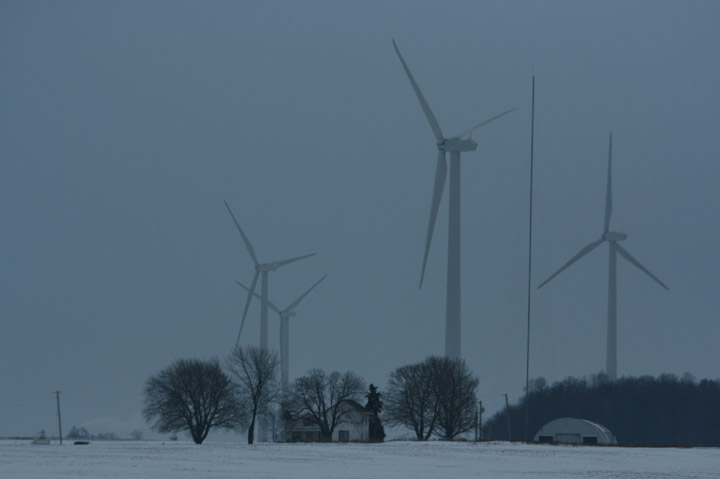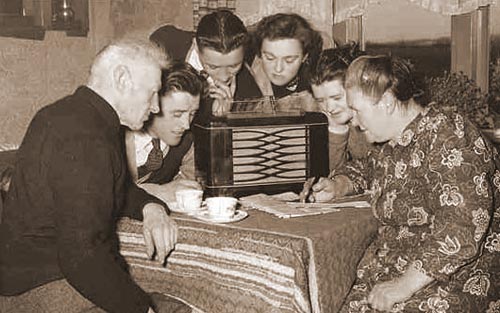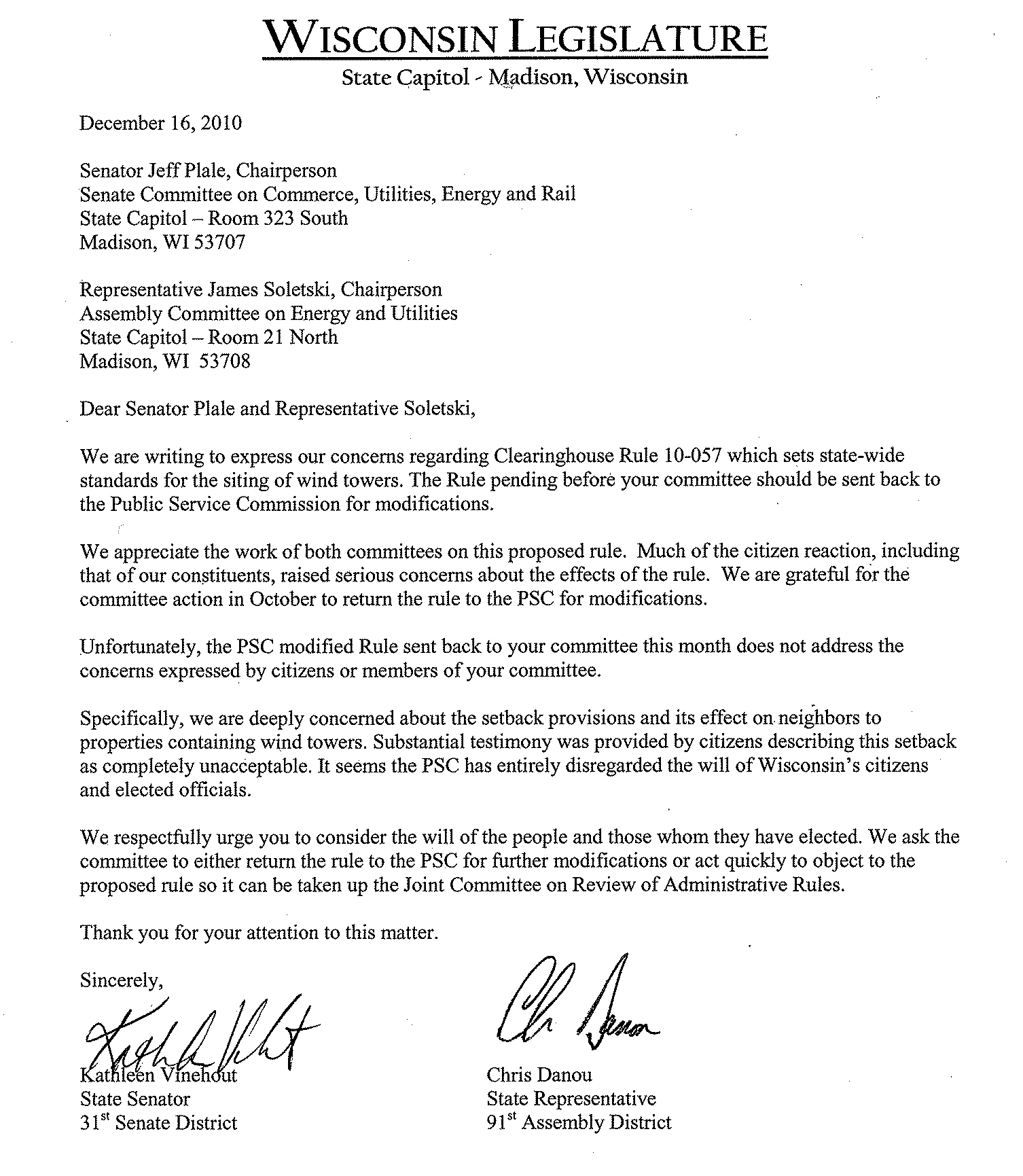Entries in wind farm shadow flicker (30)
2/4/11 Updated 5:00PM- HEARING SCHEDULED FOR WEDNESDAY: Walker bill is dead but DING DONG this issue is alive! AND Why did PSC Commissioner Azar want a 2,200 foot setback AND In the face of mounting evidence Big Wind continues to deny turbine impact on property values or health AND Is Uncle Sam Big Wind's Sugar Daddy? I ain't sayin' she's a gold digger. Wait, maybe I am.
There have been no offers on this home for sale in Invenergy Wind Project, Town of Byron, Fond du Lac County

BREAKING NEWS!
A Public Hearing regarding the PSC's wind siting rules has been scheduled for Wednesday, February 9, 10:00 AM, Room 412 East, Capitol building, Madison
A MESSAGE FROM REPRESENTATIVE AL OTT:
I am contacting you today to inform you of a Public Hearing that was just scheduled by the Joint Committee for the Review of Administrative Rules (JCRAR).
The Committee is holding a Public Hearing on PSC 128 (CR 10-057) on Wednesday, February 9th at 10:00 a.m. in Room 412 East of the State Capitol.
This Public Hearing is the first step toward suspending the effective date of the wind turbine siting standards, which are set to go into effect on March 1, 2011.
Last month, I made a formal request to the JCRAR Co-Chairs to use their Committee's authority to bring a halt to PSC 128. I asked the Co-Chairs to conduct a thorough review of the impact of PSC 128 and to take the additional step of suspending the rules in order to provide the opportunity to go back to the drawing board with this flawed product. [Click here to read the request]
As you know, Governor Walker introduced Special Session bills AB 9 and SB 9, which would have set - by statute - more stringent standards for the siting of wind turbines, both in terms of set-back distances and other provisions related to notification requirements, etc.
While it would have been my intention to support AB 9 and SB 9, for the time being, it appears that those bills will not be moved forward.
Given the March 1st effective date of PSC 128, addressing the issues created by that rule is more effectively done through action from JCRAR, rather than via legislation.
By taking action to suspend the rules, the Legislature is provided with more time, and greater flexibility, to take a more thoughtful look at these standards and to find reasonable solutions.
If your schedule allows, you are welcome and encouraged to attend Wednesday's Public Hearing.
If you are unable to attend, please feel free to submit written comments to the Committee.
Representative Jim Ott (Co-Chair) Representative Dan Meyer Representative Daniel LeMahieu Representative Gary Hebl Representative Frederick Kessler
Senator Leah Vukmir (Co-Chair) Senator Joseph Leibham Senator Glenn Grothman Senator Lena Taylor Senator Fred Risser
You can find contact information for the Co-Chairs and members by clicking on the links above or you can go to the following web links: http://legis.wisconsin.gov/W3ASP/CommPages/IndividualCommittee.aspx?committee=Administrative%20Rules&house=Joint <http://legis.wisconsin.gov/W3ASP/CommPages/IndividualCommittee.aspx?committee=Administrative%20Rules&house=Joint>
If you have any questions regarding Wednesday's hearing or the status of AB 9 and SB 9, please feel free to contact my office and ask to speak with Erin.
Sincerely,
Al Ott
State Representative
3rd Assembly District
1-888-534-0003 (toll-free)
CLICK ON THE IMAGE ABOVE TO HEAR WHY PSC COMMISSIONER LAUREN AZAR RECOMMENDED A 2,200 FOOT SETBACK.
IN THE NEWS:
LEGISLATURE WON'T TAKE UP WALKER'S WIND SITING BILL
Source: Milwaukee Journal Sentinel
February 4, 2011
By Thomas Content
A bill to restrict development of wind power projects won’t be taken up in the Legislature’s special session, but a spokesman for Gov. Scott Walker expressed confidence that the governor’s concerns about the wind issue will be addressed in a different way.
The bill is the only Walker proposal in the jobs-focused special session that didn’t clear the state Assembly.
The Legislature's focus on the wind siting issue is to not take up the Walker bill but instead use its legislative review powers to consider whether to block a wind siting standard passed last year by the state Public Service Commission from taking effect.
A hearing has now been scheduled for next Wednesday on the PSC's wind siting rule. The hearing will take place before the Joint Committee on Administrative Rules, which has the power to suspend the rule the PSC adopted.
During a bill signing in Madison Friday afternoon, Walker said he would continue to work on the issue, either by changing administrative rules or with a bill in the regular legislative session that is now under way.
“I want to see the wind industry like every other industry to be effective here in the state of Wisconsin,” Walker said. “I just want to find a way to balance that with … property rights.”
Just because Walker’s proposal won’t be voted on doesn’t mean the issue is dead, said Andrew Welhouse, spokesman for Senate Majority Leader Scott Fitzgerald (R-Juneau).
“There are still members of our caucus who have an interest in making a change. The final discussions on what that change is and what route that change is going to take through the Legislature is not determined. It’s still a work in progress,” he said.
Discussions are ongoing as to what happens next, Welhouse said.
“The fact that there is a public hearing on Wednesday should show you that there are still conversations behind had between the people involved throughout Wisconsin and the Legislature who are here to represent them,” Welhouse said.
The PSC rule called for wind turbines to be set back at least 1,250 feet from nearby homes, and also included specific limits on decibel levels for wind turbines as well as shadow flicker.
Walker rejected that approach as hurting the property rights of nearby landowners, instead proposing a bill that would bar construction of wind turbines if they are within 1,800 feet of a property line.
Supporters of renewable energy said that the bill essentially would slam the door on wind power development in the state. The bill wouldn't have affected construction of the state's largest wind farm, a 90-turbine project northeast of Madison being built by We Energies. But if it were applied to this project, the utility would have needed to get waivers to build 86 of the 90 turbines, according to an analysis by the PSC.
Cullen Werwie, Walker’s spokesman, said the governor has had success with the vast majority of his legislative proposals and didn’t view the failure of the Legislature to move the wind siting bill as a setback.
“Not at all. I don’t think the policy is dead,” he said. “The Legislature is committed to advance debate on this issue, and the governor will be continuing to work with them as they do that.”
Werwie expressed confidence that property rights concerns would be taken into account as the Legislature decides how to proceed.
Backers of the PSC standard thought the issue was resolved when the commission wrapped up work on the wind siting issue at the end of 2010.
Possible outcomes now could include having no statewide standards at all, one year after the Legislature passed a law calling for uniformity in wind standards, said Mike Brown, spokesman for state Sen. Mark Miller (D-Monona).
“This appears to be a way to accomplish the same objective without subjecting themselves to a public vote on the floor of the Senate," Brown said.
The decision not to take up the bill during the special session was first reported by The Associated Press.
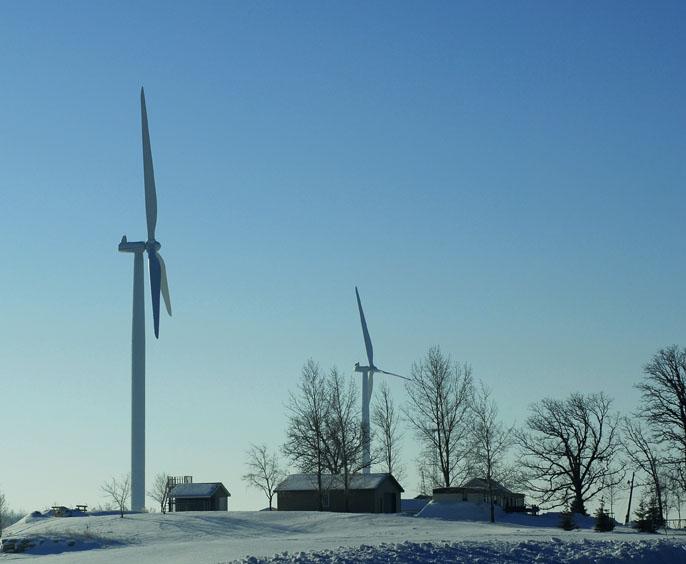 Fond du Lac County: The PSC approved setback in this project is 1000 feet from homes
Fond du Lac County: The PSC approved setback in this project is 1000 feet from homes
WALKER ISN'T GIVING UP ON TOUGHER WIND TURBINE RULE
SOURCE: www.greenbaypressgazette.com
February 4, 2011
By SCOTT BAUER
MADISON — Wisconsin's Legislature will not take up Gov. Scott Walker's proposal to toughen wind turbine regulations during a special session the governor called to pass that bill and others, spokesman for legislative leaders told The Associated Press on Thursday.
However, the demise of the bill seeking a law change doesn't mean Walker is giving up on the issue. The governor's spokesman, Cullen Werwie, said Thursday that he instead will work with lawmakers to achieve the goals of the measure through a change to Public Service Commission rules instead of a new law.
A meeting of a legislative committee that could make the rule change was announced late Thursday afternoon for Wednesday morning.
"Clearly the Republicans' assault on wind energy is not dead," said Senate Minority Leader Mark Miller, D-Monona, in a statement. He accused Republicans of protecting themselves from voting on the bill by "manipulating the administrative rules process."
Currently, turbines must be built at least 1,250 feet from nearby homes. Walker wants to push that back to at least 1,800 feet away.
The bill was introduced at Walker's request as part of a special session call he made to pass 10 bills that he said will help spur job creation. The other nine have passed one or both houses of the Legislature and four have been signed into law. But the wind bill never was even scheduled for a public hearing.
Walker, a Republican, has worked incredibly closely and well with the Republican-controlled Legislature. But that strong relationship wasn't enough to rescue the wind bill, which drew vociferous opposition from those in the industry who said it would constitute the greatest regulatory barrier in the country.
The wind bill is dead for now, but might be revived later in the session, said Chris Reader, chief of staff for Sen. Rich Zipperer, the Republican chairman of the Senate Judiciary Committee that had the bill.
"It's just an issue the Legislature wants to take a longer, more thoughtful look at," said Andrew Welhouse, spokesman for Senate Majority Leader Scott Fitzgerald. "We don't have any immediate plans to move the special session bill, but the issue certainly isn't going anywhere."
Welhouse said changing PSC rules to make the change was being considered, but there was no solid plan in place. The meeting next week was a public hearing on the issue, but no vote on any proposed rule change was planned.
Renew Wisconsin, which has tracked the growth of the state's renewable sector, had said as much as $1.8 billion in investment may be at stake if every state wind farm now in the planning stage is halted.
Chicago-based Invenergy wants to build a 100-turbine wind farm in the southern Brown County towns of Morrison, Glenmore, Wrightstown and Holland.
Invenergy's proposal called for the turbines to be set back 1,000 feet from homes or other structures such as schools and churches. A group of residents opposed to that project want the turbines set back 2,450 feet.
Denise Bode of the American Wind Energy Association said the requirement would have put a "closed for business" sign on Wisconsin for wind development.
Walker had argued his proposal would have benefited property owners. The idea had garnered support from the Wisconsin Realtors Association, which said it was needed to protect homeowners near wind turbines.
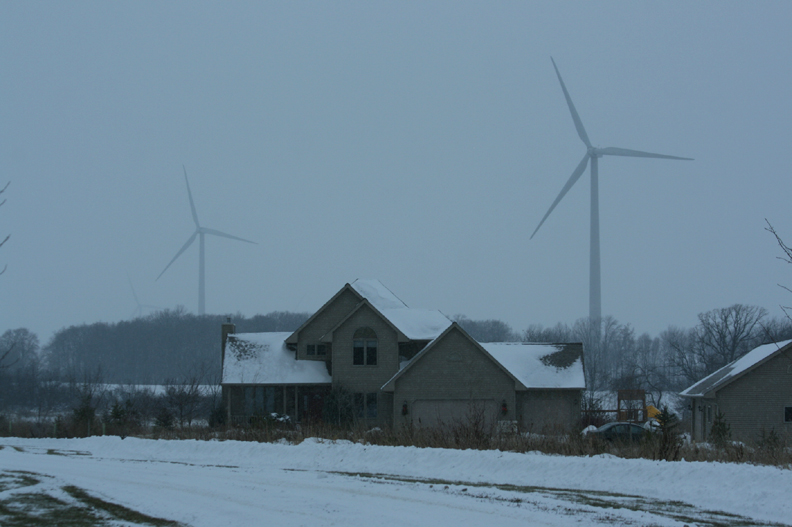
SECOND FEATURE
Illinois property value expert says:
No permits should be issued on any wind generation project without a property value guarantee for residents in the turbine area of influence. The impact zone of a wind farm is two to five miles 20 to 40 percent value loss of homes, and the complete losses for people who are forced to walk away from their homes because of wind turbine impacts
TURBINE IMPACTS REVEALED AT COMMUNITY MEETING
SOURCE: The Alpine Sun, www.thealpinesun.com
January 27 2011
By Billie Jo Jannen,
BOULEVARD — A standing-room-only crowd got an earful on the property and health impacts of industrial wind turbines last Wednesday, when experts flew in from Illinois and Canada to speak at an informational meeting held at the Boulevard Fire Station.
Speakers included appraisal consultant Mike McCann, of Chicago, Ill., Carmen Krogh, of Ontario, Canada, Bill Powers, of Powers Engineering, Dave Elliott, of Boulevard, and Donna Tisdale, also of Boulevard.
McCann – whose resume includes real estate zoning evaluations, property value impact studies, analysis of wind turbine generating facilities and evaluation of eminent domain real estate acquisitions – advised residents bluntly that no permits should be issued on any wind generation project without a property value guarantee for residents in the turbine area of influence.
The impact zone of a wind farm is two to five miles, he said. In addition to 20 to 40 percent value loss of homes in that area, there are increased costs of health care, costs to try to retrofit homes to block noise or the strobe light affect of the turbine shadows, and the complete losses of people who are forced to walk away from their homes.
Krogh, a retired pharmacist who networks with health professionals worldwide to track and document wind turbine health affects, said the impacts of both audible and inaudible sound cannot be mitigated: “The only mitigation is to remove the people from the environment they are in,” she said.
Mental and physical afflictions include sleep deprivation, headaches, heart palpitations, vertigo, tinnitus, gastrointestinal problems, anxiety and cognitive impairments, she said.
Matching results are documented in the United Kingdom, Australia, Germany, Japan, Canada and the United States – every country that has industrial turbines have health complaints.
Both McCann and Krogh said that a number of turbine neighbors had walked away from their homes, because they could not live with the impacts and no one would buy their homes. Others must find someplace away from the turbines to sleep and many have had to send their children to live with relatives to clear up various illnesses.
Adequate research on the long-term affects of turbine noise on growing children has not been done, Krogh said. However, according to Arline Bronzaft, B.A., M.A., Ph.D., who spoke at the Oct. 30 International Symposium on Adverse Health Effects from Wind Turbines, many other studies have demonstrated that intrusive noises, such as passing traffic or overhead aircraft, adversely affect children’s cardiovascular systems, memory, language development and ability to learn.
The title of Bronzaft’s presentation was “Children: The Canaries in the Coal Mine.”
In the Boulevard planning are alone, 392 turbines are wending their way through the permitting process, according to Tisdale. Hundreds more are planned in Ocotillo and Jacume, Mexico, immediately south of Jacumba. The current San Diego County wind ordinance makes no provision for property value guarantees.
“I’m calling for a moratorium pending studies of health impacts,” said Tisdale, who recently attended an international symposium of doctors, researchers and other health professionals who have documented wind turbine health effects worldwide.
She said she will be asking that the county permitting process make provision for property value guarantees, relocation of impacted residents, evidence-supported setbacks and protections in the noise ordinance to include low-frequency and infrasound effects. Neither is currently addressed in the county’s noise ordinance.
Krogh brought filmed interviews with wind turbine neighbors from Norway, Canada and Japan. The sound levels from their homes, in some cases, drowned out their voices and the nature of the sound was so distressing that audience members asked that it be turned down.
Krogh is a member of Society for Wind Vigilance, an international federation of physicians, acousticians and other professionals who seek to quantify heath risks and ensure that permitting authorities and wind turbine operators acknowledge and remedy those risks.
So far, she said, there has been great resistance from governments, who seek to provide “green” alternatives and who receive tax money from wind farm profits.
Asked what local clinics might do to mitigate health problems that could develop from proposed area wind farms, Krogh said there literally are none, though local health professionals help by gathering information: “A clinic can assist by documenting impacts to its patients.”
Industrial wind farm operators in the United States and Canada, most of whom receive taxpayer supported benefits and highly favorable permit conditions, resist revelations of adverse effects by requiring property owners from whom they lease lands to sign non-disclosure agreements, McCann said.
The few off-site residents that have received buy-out offers from wind companies are required to sign non-disclosure agreements as a condition of the buy-out.
McCann added that property value losses are not offset by local jobs or by lease payments to property owners. The leases are often predicated on the power the turbine produces and few of them actually work at maximum capacity. Hence, “They (landowners) aren’t getting what they were promised,” he said.
“Always have a lawyer look at the lease document before you sign it,” he advised.
Among the small print items to be aware of is what it going to happen to the turbine when it is taken out of service. The I-10 in Nevada is littered with the carcasses of turbines that are no longer useful, but they have never been removed, he said.
Large companies further “defuse their liability” by creating smaller limited liability companies to actually own and operate the wind farms, McCann said.
Elliott, a member of the Manzanita Band of Mission Indians, monitors, and tries to mitigate, the cultural impacts of the Sunrise Powerlink and the wind projects. He said that Indian burial sites and other cultural sites in both private and public lands are being destroyed by these projects, with very little effort to protect them.
“This project is all about big business … it’s about trillions of dollars,” Elliott said. “As Native Americans, we’re last on the totem pole.” Elliott said he has encountered hostility from homeowners, who may be mistaking his efforts to identify cultural sites as further intrusion by SDG&E.
“I support the landowners’ efforts to protect their lands,” he said. “I hope the landowners will support our efforts too.”
Several meeting attendees, one who lives as far as two miles from the existing wind farm on Campo Reservation, commented that they can hear the turbines clearly, even inside their homes. McCann said that wind turbine noise can travel up to nine miles in mountain terrain.
Property value impacts start to show up as soon as even the possibility of a project becomes known, according to McCann. The phenomenon even has a name among appraisal professionals: wind farm anticipation stigma.
In a comment paper on the Brucci MET tower on La Posta Road, he asserted that the construction of a meteorological testing tower “serves as constructive notice to existing neighboring property owners and any potential buyers” that wind turbines may come in later – and that is enough to drive homebuyers elsewhere.
According to nolo.com, a law information website, California sellers must disclose any and every natural and manmade hazard that might affect the value of the property. This includes everything from neighborhood nuisances, such as a dog that barks every night, to major hazards like floods, earthquakes, fires, environmental hazards, and other problems. Failure to make the required disclosures not only costs the seller in a lawsuit, but can also carry criminal penalties.
So what is a homeowner to do if his home is untenable and no one else wants it either? “It’s really sad to talk to these people who put their life savings into their homes and then have to walk away from them,” McCann said.
The mass erection of wind turbines near people’s homes is a form of taking from the property owner and giving to the wind developers, he added: “It’s not OK to rob from Peter to pay Paul.”
The county’s wind ordinance calls for permitting requirements to state noise limitations at the property line, but makes no provisions for property value protections or mitigation of health impacts, according to Planning Manager Joe Farace of San Diego County Department of Planning and Land Use.
That’s a different realm from what we do,” Farace said. State and federal environmental and planning laws don’t require that these impacts be quantified or mitigated, though the county could, if it wished, explore going beyond those minimums.
“This is so new,” he said. “We’d have to work with county counsel to see what we could do.”
Farace said there are no plans, currently, to pursue such a discussion.
THIRD FEATURE:
WIND PROJECTS BACKED BY TAX CREDITS AND SUBSIDIES
SOURCE: VPR News, /www.vpr.net
February 3, 2011
by John Dillon
(Last of Three Parts) Most people think of big wind projects as a way to harvest the breezes that blow freely across the earth.
But sophisticated investors look at big wind quite differently. That’s because besides generating electricity, the large-scale projects also involve sophisticated financial instruments that harvest a variety of tax benefits.
In the last of our series on big wind, VPR’s John Dillon has this look at how the projects are financed.
(Dillon) This is a story about finance, tax credits and energy subsidies. So point number one. Almost all energy production is subsidized.
Nuclear power, for example, is backed up by the federal government. If a reactor melts down, the feds are ready to underwrite the monumental insurance costs.
Some oil company subsidies date to the 1920s.
Tax incentives and subsidies for renewable resources are much more recent. Now, says energy developer John Warshow, the government assistance is seen as an essential part of the complex financing for these projects.
(Warshow) “Developing a project is like juggling with being blindfolded and having five balls you got to keep track of. You’ve got your debt financing, your equity financing, your power sales.”
(Dillon) In his younger, scruffier days, Warshow fought nuclear power. He later turned his activism into action. His office wall in Montpelier features pictures of some of the renewable enterprises he’s helped launch, including hydro projects in Vermont and wind in New York state.
Although wind is free, the projects are expensive to start with because of the cost of the turbines, the land and the permitting requirements.
Which leads us to point number two. Because of that expense, private financiers are needed along with the government support. Investors use the tax credits to offset their income.
(Warshow) “Generally there are investors, either individual or corporate investors, who put cash into the project.”
(Dillon) To raise all the money they need, the developers’ financing resembles a multi-layered birthday cake. The tax financing piece is one layer; power sale contracts are another. Loans are yet another piece of the overall package. Warshow outlines the three main incentives used by wind investors. There are direct payments allowed under the recent stimulus bill, tax credits for energy production, and tax credits for investment.
(Warshow) “You can’t do all three, you have to pick which one is most appropriate for you.”
(Dillon) The production tax credit basically cuts the cost of electricity that’s sold. That helps the power producer. The investment tax credit – as the name suggests – is more geared for the investor. Warshow does the math on a hypothetical project that costs $40 million dollars.
(Warshow) “Maybe half of that might be debt so that would be $20 million. And the equity investors would be entitled to 30 percent of that $40 million if they took the tax credit, so that would be $12 million they would get back pretty much instantly on their investment.”
(Downes) “These are tax shelters for the investors. Pure and simple. They are nothing more than that.”
(Dillon) William Downes is a financial analyst in Maine who has looked closely at wind financing. He says the tax credits have a market of their own. They can be bundled and re-sold to companies, hedge funds or individuals.
(Downes) “Whatever investor they bring in is obviously a big institution with a lot of taxable income they want to shelter.”
(Dillon) Downes says companies and investors also take advantage of accounting rules that allow for accelerated depreciation of turbines and other equipment. He says the investments can be lucrative.
(Downes) “So, in effect, the investor will get an after-tax return of 7-8 percent, maybe higher.’
(Dillon) Just as nuclear power wouldn’t be viable without the federal insurance guarantee, many wind projects wouldn’t be built without the various tax breaks.
Green Mountain Power has made this point before the state Public Service Board. The company says it has to have the Lowell Mountain project up and running before the end of December 2012, when the production tax credits expire.
(Dostis) “Without those we would probably shelve the project for a while until either the tax credits were available or economics changed.”
(Dillon) Robert Dostis is a GMP vice president. He says that because GMP’s rates and profits are set by regulators, customers reap the benefits of the tax credits.
(Dostis) “The production tax credit that expires in 2012 is important because it keeps the cost of the project down. And that savings go directly to what the customer pays.”
(Dillon) But there’s still a third point to be made. Even with the tax advantages, wind projects are not guaranteed money-makers.
First Wind in Boston is an example. It’s developing a project in Sheffield in the Northeast Kingdom.
Late last year, the company was poised to sell stock to the public, so its financing is detailed in a filing with the Securities and Exchange Commission. The documents show the company has high debt and negative cash flow. Spokesman John Lamontagne says tax credits help the company compete with other energy sources.
(Lamontagne) “The tax credits allow renewable energy projects to be operating on a level playing field with fossil fuels. Fossil fuels also receive significant levels of government assistance.”
(Dillon) But even with the help of the tax credits, First Wind also has about $528 million in long-term debt. The company told the SEC that if it can’t meet the loan terms it could be forced to declare bankruptcy.
It turned out investors weren’t willing to pay what First Wind wanted of them. So it canceled its stock offering. And added to its existing debt. To build the Sheffield project, it borrowed another $76 million.
For VPR News, I’m John Dillon in Montpelier.
2/3/11 POST UPDATED at 5:00pm WALKER'S WIND BILL IS DEAD and Hey Mister, you want to buy a Wisconsin wind project that isn't even finished yet? AND Wait a minute, how big are those turbines again? AND Tell it to the Judge: Wind lawsuit in Ontairo update
WALKER'S WIND BILL DEAD
February 3, 2010
By
SCOTT BAUER
Associated Press
MADISON, Wis. (AP) — Gov. Scott Walker’s proposal to toughen wind turbine regulations will not be taken up by the Legislature in a special session the governor called to pass that bill and others, the Associated Press was told Thursday by spokesman for legislative leaders.
The demise of the bill mark’s Walker’s first legislative defeat in an incredibly successful first month in office.
The bill was introduced at Walker’s request as part of a special session call he made to pass 10 bills he said will help spur job creation. The other nine have passed one or both houses of the Legislature and four have been signed into law.
But the wind bill never was even scheduled for a public hearing.
The bill is dead for now, but might be revived later in the session, said Chris Reader, chief of staff for Sen. Rich Zipperer, the Republican chairman of the Senate Judiciary Committee that had the bill.
GO TO THE DAILY REPORTER’S
WIND FARM PROJECT PROFILE PAGE
“It’s just an issue the Legislature wants to take a longer, more thoughtful look at,” said Andrew Welhouse, spokesman for Senate Majority Leader Scott Fitzgerald. “We don’t have any immediate plans to move the special session bill, but the issue certainly isn’t going anywhere.”
Walker spokesman Cullen Werwie did not immediately respond to a message seeking comment. Leaders in the Assembly also did not immediately return calls, but the bill has not been scheduled for a hearing there.
Walker, a Republican, has worked incredibly closely and well with the Republican-controlled Legislature.
But that strong relationship wasn’t enough to rescue the wind bill, which drew vociferous opposition from those in the industry who said it would constitute the greatest regulatory barrier in the country.
Currently, turbines must be built at least 1,250 feet from nearby homes. But under Walker’s plan, they would have to be built at least 1,800 feet away.
Renew Wisconsin, which has tracked the growth of the state’s renewable sector, had said as much as $1.8 billion in investment may be at stake if every state wind farm now in the planning stage is halted.
Denise Bode, of the American Wind Energy Association, said the requirement would have put a “closed for business” sign on Wisconsin for wind development.
Walker had argued his proposal would have benefited property owners. The idea had garnered support from the Wisconsin Realtors Association, which said it was needed to protect homeowners near wind turbines.
SECOND FEATURE
BROWN COUNTY WIND PROJECT ISN'T DONE YET, BUT IT'S ALREADY FOR SALE:
SHIRLEY 'UN-WINDS' ---SHIRLEY WIND PROJECT FOR SALE, DEVELOPERS STILL KEEN ON ADDRESSING RESIDENTS CONCERNS.
SOURCE: The Denmark News, thedenmarknews.com
February 3, 2010
Central Hudson Gas & Electric Corporation (CHG&E) of Poughkieepsie, NY, which owns roughly ninety percent of the Shirley Wind Project, has begun the process of selling the 20 MW energy production facility.
The project has yet to even be completed and already the utility is courting buyers, although they say the move has more to do with a shift in corporate strategy versus the pros and cons of the Shirley installation itself.
John Maserjian, CHG&E spokesman for the Shirley WInd project confirms, "That is true. In October our Board of Directors announced a change in strategy for CH Energy Group and we're looking to refocus the company on our utility operations in New York and also our fuel distribution operations in the Mid-Atlantic area. So we're looking to 'unwind' our investments in renewable energies including the Shirley Wind investment. We're moving in that direction. We're not at the point where we can announce any prospects or interest, but we're taking the preliminary steps."
CHG&E also has minority investments of about $5 million in two other wind projects, a 7.5 MWt wind farm located in Atlantic City, NY and a 24 MW facility in Bear Creek, PA. Maserjian says CHG&E us 'unwinding' (a fancy term for selling) all of their investments in renewable, not just the Shirley project.
"There's a biomass plant in upstate New York that produces steam and electricity from wood products that located near a lumbering site that's for sale as well. We also have an interest in an ethanol plant in Nebraska that will be sold," he said.
In a press release dated October 28 2018, just under two weeks before the quiet ribbon cutting for the Shirley Wind facility, CHG&E Chairman of the Board, President and C.E.O. Steven V. Lant said "[W]e have concluded that we do not possess the same strong competencies and competitive advantages in renewable energy.
These investments do not typically display the risk and return profiles that are consistent with our financial objectives, requiring higher levels of leverage and more volatility than we are comfortable with. As we announced last quarter, we have discontinued development efforts in this area, and we will no begin to unwind the existing investment portfolio in an orderly manner."
The unexpected news will probably excite wind farm critics, who in addition to any number of personal concerns, have called wind turbine development a costly mistake. Many critics of the subsidized fledgling wind industry claim the costs associated with wind energy raise the flag of increased electricity prices as well as irrecoverable tax moneys used to spur development.
Bill Rakocy, one of the founders of the project developer Emerging Energies LLP, declined to comment on the impending sale, but the move appears to be somewhat unexpected.
Maserjian continues, "It was not our intention to sell the project when we first made the investment, but over the course of the year we re-evaluated our strategy and our operations and decided that it would be in the best interest of our investors to sell, or 'unwind' our renewable energy investments.
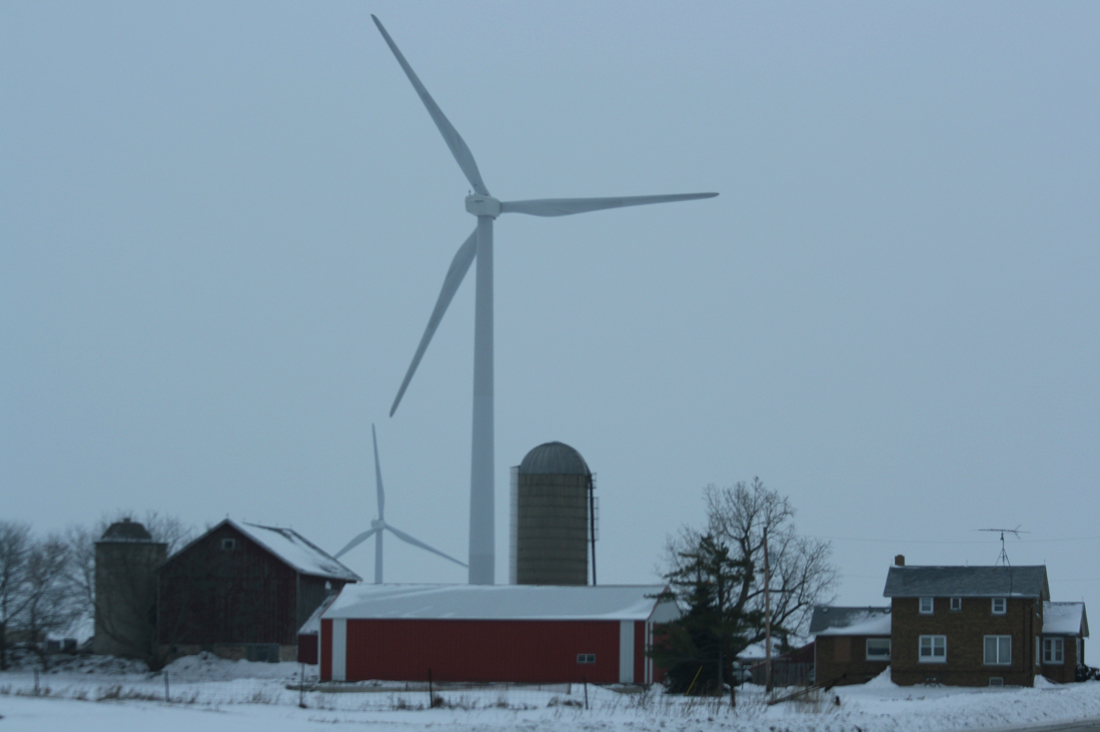 Turbines being built in Wisconsin are ten stories taller this one in Fond du Lac County
Turbines being built in Wisconsin are ten stories taller this one in Fond du Lac County
THESE ARE NOT YOUR GRANDMA'S WINDMILLS
SOURCE: Janesville Gazette, gazettextra.com
February 3, 2011
By DOUG ZWEIZIG,
Why does Gov. Scott Walker’s wind siting bill include a 1,800-foot setback between wind turbines and property lines? Because the newest industrial wind turbines in our state are 50 stories tall. It’s hard enough to imagine living next to a structure that big. Now add blades that weigh 18 tons with a span wider than a 747, a top speed of about 170 mph, spinning 24/7 just 1,250 feet from your door.
Imagine living with turbine noise that is twice as loud as the World Health Organization’s limit for healthful sleep. Imagine 700 feet of your land used by a wind company without your permission and without compensation. Imagine a loss of property value as high as 40 percent.
Unfortunately on March 1, unless Walker’s bill passes, this will become a reality. That’s when the new state Public Service Commission’s wind siting rules take effect.
I served as vice chairman of the PSC’s Wind Siting Council. The majority of the council had a direct financial interest in the outcome of the rules, resulting in guidelines that protect those interests instead of protecting Wisconsin residents. I helped author a minority report to the PSC, detailing how the majority’s guidelines fail to address the realities of the effects of large wind turbines on nearby populations.
Wisconsin residents have been living with turbines of the 400-foot to 500-foot variety for only a few years, but the problems with PSC setbacks once thought to be adequate have become very clear. Neighbors of wind projects traveled to Madison to give sworn testimony to the PSC and to our legislators, telling of turbine noise much louder than expected, of sleep deprivation and resulting deterioration of health, of headaches from shadow-flicker, loss of TV and radio reception, complaints to wind companies that are ignored, communities torn apart and homes that simply will not sell.
The PSC rules will allow wind companies to put a turbine 440 feet from your property line and claim about 700 feet of your land for use as their safety zone. It’s still your property, but you can’t build a structure or plant trees there without the wind company’s permission.
All of these problems can be avoided with greater setbacks.
Gov. Walker’s bill puts a setback of 1,800 feet between a turbine and your property line. If a company wants to put a turbine closer, it absolutely can. The difference is it will need your permission and might have to compensate you. The bill ensures that a wind company can’t take your property for its use unless you want it to.
Although the bill does not directly address the very real health concerns associated with living too close to wind turbines, it gives us increased protection from turbine noise and shadow flicker and protects our property. Most important, it gives us some choice.
I hope you’ll call your legislators and ask them to support Walker’s bill. If we put turbines where they do no harm, everyone will be happy.
Doug Zweizig of Evansville served as vice chairman of the state Public Service Commission’s Wind Siting Council.
Second Feature
TURBINES GET LOUDER AT NIGHT: ACOUSTICIAN
SOURCE: ifPress
February 3, 2010
By Ellwood Shreve
CHATHAM - Wind turbines make more noise at night, according to acoustics expert Rick James.
James provided testimony during the second day of an Ontario Environmental Review Tribunal, held in the council chamber of the Chatham-Kent Civic Centre. He testified on behalf of appellants Katie Erickson and Chatham-Kent Wind Action Inc., who are opposed to the approval of the Kent Breeze Wind Farm in Thamesville, owned by Suncor.
An appeal has been launched against the wind farm project, which is the first to be approved under the Ontario Green Energy Act, on the basis it will cause harm to human health such as sleep disturbances, stress or psychological stress, headaches and loss of enjoyment of life.
James said he has measured differences in sound levels at night and the daytime at other wind farms as well as examined other studies on how the wind speed affects turbine blades at different levels in the rotation.
"It's not that the wind speed changes, it's that the difference in the wind speed at different points in the blade's rotation may be great enough that it's not possible to set that blade at an angle that is optimal for energy extraction," James said.
He said in engineering terms, noise is wasted energy.
"When we get to where the blade is in those positions where it's not at the optimum angle to extract energy we get a little extra noise off of it," James said. "The more out of alignment the more noise we get."
He said in the daytime a blade being out of alignment only increases noise by one, two or three extra decibels.
At night, when there are less sounds from other sources to mask the noise, the difference in wind speeds hitting different points in the blade's rotation can create a thump or a deep whoosh sound, much more intense than what is experienced in the daytime. He noted this could be a 10-to 14-decibel increase.
James studied the Kent Breeze Wind Farm area and figures more than 100 homes in the area of where the eight turbines are to be located will be above the 40-decibel at nighttime, if the increased noise level is factored in.
Albert Engel, lawyer for Suncor, said if the company or another proponent finds that a turbine is exceeding an acceptable noise level, action can be taken to reduce the noise.
James said he is not aware of any mitigation efforts that have reduced the increase in nighttime noise caused by wind turbines.
Andrea Huckins, co-counsel for the Ministry of Environment, pointed out James doesn't have the medical qualifications to make any conclusions that human health will be affected by the Kent Breeze Wind Farm.
James said he doesn't need a medical designation to know people who have been put in a similar situation have made health complaints.
Both Engel and Huckins tried unsuccessfully to convince the tribunal to not allow James to stand as an expert witness, claiming his bias as a board of director of the Society for Wind Vigilance, and the fact he has testified on behalf of several clients opposing wind farms.
The tribunal resumes Feb. 9-11 in Toronto, returning to Chatham Feb. 15-16. Sessions will be held in Toronto March 2, 4,11, 25, then in Chatham March 22, 23, 29-31.
Some appelants' witnesses will testify in-camera.
Eric Gillespie, lawyer representing the appellants said some information that certain witnesses would like to present is part of a study recently completed in Maine, which looked at the relationship between the location of industrial turbines and health effects on residents.
Noting it is believed to be a first of its kind, Gillespie said the authors of the study want it to try to have it published in a peer-reviewed scientific journal. He added if the information is publicly disseminated through a legal proceeding or other mechanism it could hinder having it published, because it becomes "yesterday's news."
1/28/11 UPDATED: Life in a Wisconsin wind project: who is listening to the residents? AND Update on Big Wind lawsuit in Ontario AND Wind project resident suffers heart-attack during presentation about turbine noise violations AND Stray Voltage and Wind Turbines
THE NOISE MOVED IN NEXT TO THE HOMEOWNERS
SOURCE Journal Sentinel, www.jsonline.com
January 27, 2011
By Patrick McIlheran
In Thursday’s Journal Sentinel, I talk with the neighbors of some wind projects. Frankly, I think wind turbines are pretty atop the ridge south of Fond du Lac, but I don’t live near them. Gerry Meyer does, and he recounts just how loud they are — like a jet plane flying over, or like boots in the clothes dryer.
That’s why, he tells me, he thinks the 1,800-foot line specified in Gov. Scott Walker’s bill on wind turbine siting makes sense. It isn’t a setback — rather, the bill simply requires that anyone putting a wind turbine closer than 1,800 feet to a property line get the permission of the owner on the other side.
Wind advocates say that will kill wind power in Wisconsin. It’s “highly unlikely,” said Clean Wisconsin’s Keith Reopelle, that developers would want to negotiate with neighbors, much less pay them compensation, the likely means by which such permission would be gained.
Besides, said Reopelle, it’s not as if wind turbines are the only noisy thing out there. He mentioned how he used to live along the edge of Interstate 90 south of Madison.
“We’ve never talked about monetary compensation for people who live near highways,” he said.
True enough, but there’s a critical difference: I-90 was a freeway long before Reopelle ever moved next to it. By comparison, rural southern Fond du Lac County was field and wood until about two years ago. Characteristic noises would include the footfalls of deer. “I have not seen a deer here since construction began,” said Meyer, and the owls and hawks that used to frequent his woodlot are gone, too. While someone choosing to live near a freeway is moving next to the noise nowadays (since we’re not building new freeways), in the case of wind farms, the noise is moving in.
FAIR AND OPEN PROCESS? MORE LIKE OUTNUMBERED AND IGNORED SAY TURBINES' NEIGHBORS
SOURCE: Journal Sentinel, www.jsonline.com
January 27, 2011 By Patrick McIlheran
If you look at my column in Thursday’s Journal Sentinel about wind turbines, you’ll notice one of the people I talked to is Larry Wunsch, who lives 1,100 feet from a turbine near Brownsville.
Wunsch was on the panel that the Public Service Commission assembled to advise it on wind turbine siting rules. The PSC was told by the Doyle administration to trump town and county rules on how far turbines should be from houses, and it picked a number, 1,250 feet, that wind advocates say is plenty far enough.
In fact, say advocates, the number is a compromise — tougher than they wanted but less than what wind farm critics sought. “A fair decision arrived at,” said Denise Bode, head of the American Wind Energy Association. The number was arrived at via an open process involving all kinds of stakeholders, she said.
It’s true that wind turbine critics wanted a farther setback — one figure that gets thrown around is a 2-kilometer setback, or more than 6,000 feet. But that the PSC’s figure is less than critics wanted and more than developers did proves nothing about the process that produced the PSC’s rule.
Was, in fact, the process fair? Not really, says Wunsch. For one thing, the PSC’s panel was heavy with advocates of wind, he notes. By law, it had to include two wind-farm developers, two utility representatives (utilities favor easier wind-farm siting), one university expert, one township official, one county official, two real estate reps (who generally want tighter limits), two wind-farm neighbors, and two members of the general public. In this case, one of the members of the public was a former Doyle functionary; the other was Jennifer Heinzen, who happened to be an offical with RENEW Wisconsin, a pro-wind group. It mean RENEW had two people on the council.
“A member of the public should be Joe down at the bait shop,” said Wunsch, and while you might think so, state law made no such specification.
As for whether the council did much listening, again, Wunsch contends it didn’t. He contends he tried playing recordings he made outside his home of turbine sounds — along with sound-meter readings of between 50 and 60 decibels — and was turned down. He says he later suggested just playing an hour of turbine noise he recorded in his backyard during the proceedings as a show of what neighbors endure. “I was told by chair that I could not do that. Any experiment I tried to bring to them they weren’t interested.”
Obviously, a majority of the council disagreed with Wunsch, but that doesn’t lessen the fact that, however lawful and public the process, the neighbors of wind farms felt they weren’t consulted so much as outnumbered and trumped.
Click on the video above to hear what wind turbines sound like. Video recorded by Gerry Meyer who lives in the Invenergy Forward Energy Wind Project. Video camera microphones aren't sensitive enough to fully record wind turbine noise. Even so, the distinct quality of wind turbine noise is very clear here.
CLICK HERE to read Meyer's daily account of life with wind turbines in The Brownsville Diary,
CONCERNS ARE ADRIFT IN THE WIND
SOURCE: Journal Sentinel, www.jsonline.com
January 26, 2011
Patrick McIlheran
If anyone had to ask Gerry Meyer for permission to install a wind turbine 1,560 feet from his house, it isn’t clear he’d have said no.
“At one time, I supported this, because I didn’t know any better,” said Meyer, who lives amid the 86-turbine wind farm south of Fond du Lac, near Brownsville. “I was naive.”
But no one had to ask Meyer anything. As turbines and their neighbors are back in the news, with wind proponents saying Gov. Scott Walker’s proposed change to siting rules will kill wind power in Wisconsin, one thing is becoming clear: Wind backers aren’t doing enough asking or listening to neighbors.
Neighbors are listening, whether they want to or not, to the turbines. Builders say they’re quiet, and Meyer said he believed that – until he stepped outside and looked up for the jet flying over. It was the new turbine nearby. Depending on wind and humidity, any of the five turbines within a mile of his house obtrude on the quiet, whining or thumping “like boots in the dryer.”
Within weeks, his wife and son started having chronic headaches. His wife now suffers constant ringing in her ears. It vanished on vacation. Meyer no longer sleeps much – “The only time I dream is when we go to our cabin,” he said – and he says his blood chemistry’s now a mess. His cortisol returned to normal, and he lost 21 excess pounds when the turbines were off for three weeks. “That should raise a red flag,” he said.
A mail carrier, Meyer talks of dogs grown surly and neighbors who have abandoned farms. One neighbor, Larry Wunsch, 1,100 feet from a turbine, cites “shadow flicker,” when sunlight shines through the blades. “It looks like someone is turning the lights on and off,” he said. The state “says you should be able to put up with that for 40 hours a year.” He can’t. He’s been trying to sell for more than a year.
Elsewhere near Fond du Lac, turbines’ neighbors mention the jet-like noise. “Sometimes it sounds like a racetrack or a plane landing,” Elizabeth Ebertz, 67, of St. Cloud, told the Wisconsin State Journal in August. “They’re just too close to people.” Allen Hass, 56, a Malone farmer, told the paper the rent he got for hosting a turbine couldn’t make up for headaches. “I wish I never made that deal,” he said.
Distance is at issue now that Walker proposes changing the uniform setback the state adopted last year. The Public Service Commission overrode stricter local rules, saying turbines had to be at least 1,250 feet from homes. Walker proposes 1,800 feet from property lines, a distance backers say will kill the wind industry. The existing standard is strict enough, says Denise Bode, head of the American Wind Energy Association, and changing it leaves little room for turbines.
Except Walker’s bill doesn’t say turbines must be 1,800 feet from anything – only that if they’re closer, the neighboring owner must grant permission.
Wind backers feel that’s not workable, says Keith Reopelle of Clean Wisconsin, a group favoring turbines. Neighbors would demand payment, “raising the price of wind power and making wind power less competitive,” he said.
Well, yes, neighbors do complicate things. So do lawsuits, like the one Clean Wisconsin joined to try stopping We Energies’ new low-pollution Oak Creek power plant; the settlement will raise your power bills by $100 million. There are lots of trade-offs in generating electricity, and wind is no exception.
The difference is that with wind, the burden falls heavily on people right next door. It lowers theirproperty value, it affects their health in ways not yet understood and it can be alleviated by paying neighbors for their trouble, a deal that Walker’s bill encourages.
But wind backers aren’t inclined to bargain or even acknowledge a problem. “We live with lots of noises,” such as from roads, said Reopelle. Bode, asked about complaints, replied, “There are always going to be some folks who don’t want development.”
Nothing wrong with development, said Meyer, “but what about our health?” The wind farm, he said, “has completely taken away our quality of life.” Of such complaints, wind’s proponents hear nothing.
SUPPORT SENATE BILL 9: WALKER'S WIND SITING REFORM
Better Plan encourages you to take a moment right now to contact Governor Walker's office to thank him for the provisions in Senate Bill 9, (CLICK HERE TO DOWNLOAD THE BILL) which provides for a setback of 1800 feet between wind turbines and property lines. Let him know you support this bill.
CONTACT
Governor Scott Walker
govgeneral@wisconsin.gov
115 East Capitol
Madison WI 53702
(608) 266-1212
RED ALERT!
It's very important that you contact these key legislative committee members and urge them to support this bill and vote to move it forward. Every phone call and email to these committee members matters.
Members of the Senate Committee on Judiciary, Utilities, Commerce, and Government Operations.
-Chairman Senator Rich Zipperer (R) Sen.Zipperer@legis.wisconsin.gov
(608) 266-9174 Capitol 323 South-Vice Chair Senator Neal Kedzie (R) Sen.kedzie@legis.wisconsin.gov
(608) 266-2635 Capitol 313 South-Senator Pam Galloway(R)
Sen.Galloway@legis.wisconsin.gov
(608) 266-2502 Capitol 409 SouthSenator Fred Risser (D) Sen.risser@legis.wisconsin.gov
(608) 266-1627 Capitol 130 SouthSenator Jon Erpenbach (D) Sen.erpenbach@legis.wisconsin.gov
(608) 266-6670 Capitol 106 SouthAssembly Committee on Energy and Utilities
Representative Mark Honadel (Chair)(888) 534-0021 (414) 764-9921 (South Milwaukee)
Rep.honadel@legis.wisconsin.gov
Representative John Klenke (Vice-Chair)(888) 534-0088 (Green Bay) new
Rep.Klenke@legis.wi.gov
Representative Kevin Petersen(888) 947-0040 (Waupaca)
Rep.Petersen@legis.wisconsin.gov
Representative Gary Tauchen(608) 266-3097 (Bonduel)
Rep.Tauchen@legis.wisconsin.gov
Representative Thomas Larson(888) 534-0067 (Colfax) new
Rep.Larson@legis.wi.gov
Representative Erik Severson(888) 529-0028 (Star Prairie) new
Rep.Severson@legis.wi.gov
Representative Chad Weininger(888) 534-0004 (Green Bay) new
Rep.Weininger@legis.wi.gov
Representative Josh Zepnick(608) 266-1707 (414) 727-0841 (Milwaukee)
Rep.Zepnick@legis.wisconsin.gov
Representative John Steinbrink(608) 266-0455 (262) 694-5863 (Pleasant Prairie)
Rep.Steinbrink@legis.wisconsin.gov
Representative Anthony Staskunas(888) 534-0015 (414) 541-9440 (West Allis)
Rep.Staskunas@legis.wisconsin.gov
Representative Brett Hulsey(608) 266-7521 (Madison)
Rep.Hulsey@legis.wi.gov
And be sure to contact your own legislators and encourage them to support the bill.
SECOND FEATURE
TURBINES, GREEN ENERGY ACT, FACE COURT CHALLENGE
SOURCE: Orangeville Citizen, www.citizen.on.ca
January 27, 2011
By WES KELLER Freelance Reporter,
The fate of Ontario’s Green Energy Act (GEA), as it relates to wind turbines, might hinge on whether a Divisional Court panel of three Superior Court judges rules that the government should have sought proof that there are no harmful health effects from turbines or rules that the government considered adequately whether a standard setback of 550 metres is safe.
An application for a judicial review, brought by lawyer Eric Gillespie representing Prince Edward County resident Ian Hannah, was heard Monday in Toronto over objections from government lawyer Sara Blake, who argued that the court had no jurisdiction as it involves a wind farm proposal that should be subject to the Renewable Energy Approval (REA) process.
The Canadian Wind Energy Association (CanWEA) is a party to the hearing but only as “a friend of the court” and so far only apparently to the extent of submitting information. But its position reflects that of the government.
“In our view this application has no merit and should not be before the court. The proper forum for issues related to setbacks for wind turbine projects is through the Renewable Energy Approval (REA) process. The REA is designed to ensure that renewable energy projects are developed in a way that is protective of human health, the environment, and Ontario’s cultural and natural heritage,” said CanWEA’s media relations officer, Ulrike Kucera in an email response.
The judges have reserved their decision to allow time to review the complex submissions from both sides, but Wind Concerns Ontario is considering that a victory. It says essentially that to have had the case heard at all was a win, and cites three hurdles that it consider it has overcome.
First hurdle: having the case heard;
Second hurdle: the court heard evidence from experts whom the government side said were unqualified;
Third hurdle: the fact of the reserved judgment, as an indication that the panel is reviewing all submissions – including those of the turbine opponent.
Mr. Gillespie’s submissions generally were that the provincial ministry did not consult doctors and did not follow what is known as “the precautionary principle” by which a proposal should be rejected if there is uncertainty about its effects.
Ms. Blake defended the process of the GEA drafting as, she said, the minister reviewed scientific studies. She said the doctors cited by Mr. Gillespie lacked the (expert) qualifications required, and described one of them as “an advocate against wind farms” because an area near his home is being considered for a possible wind farm.
On Tuesday, Mono council unanimously passed a motion by Councillor Fred Nix, asking the provincial government undertake independent third-party clinical research on the health effects of low-frequency noise from wind turbines on nearby residents.
In an interview, Mr. Nix said the motion was largely symbolic, since municipalities have limited authority under the Ontario Green Energy Act.
“This says to the government what a rural municipality thinks,” said Mr. Nix. “They say a safe setback for turbines is 550 metres.
“Do we have a research that says this is safe? I say we don’t.”
While he admitted a motion passed by a single, relatively small municipality bears practically no weight, Mr. Nix was hopeful the message would bring other towns and cities on side and they could make their collective case through the Association of Municipalities of Ontario (AMO) or the Rural Ontario Municipal Association (ROMA).
“There is strength in numbers, he said,” he said. “We will have a lot more powers if we can get more municipalities on our side.”
The outcome of the court hearing is of vital interest to the Whittington Coalition for Our Right to a Healthy Living Environment, the group opposing a 6.9 megawatt wind turbine installation at Mono- Amaranth Townline and 15 Sideroad, in large part because they believe the 550-metre setbacks are inadequate.
But it is of critical interest to the Ontario government itself as it has been relying on a deal with Samsung and a South Korean turbine service proponent to create thousands of industrial jobs while bolstering Ontario’s production of green wind energy.
THIRD FEATURE
SOURCE: Wind Turbine Syndrome News
Art Lindgren, a leader of the effort opposing excessive noise from Vinalhaven wind turbines, suffered a heart attack last night at a board meeting of the Fox Island Electric Cooperative.
Lindgren had been in the midst of an evening presentation about the reporting by Fox Island Electric to ratepayers and ongoing complaints about violations of state noise standards. The informal entity Mr. Lindgren leads—Fox Islands Wind Neighbors—has urged the State of Maine to enforce the law against Fox Islands Wind, the turbine operator.
At considerable effort, cost, and often under severe weather conditions, Mr. Lindgren mastered complex acoustic measurements, providing data from wind turbines from this rural, quiet area in Maine.
Lindgren was airlifted from Vinalhaven, ten miles from the Maine coast, by LifeFlight helicopter last night after being resuscitated by observers.
He is under treatment at Eastern Maine Medical Center in Bangor, ME.

Art Lindgren, Vinalhaven, ME
Below, a view of a wind turbine from the Lindgren home
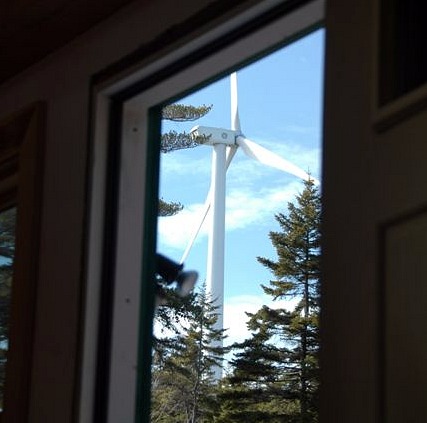
Stray voltage an ongoing issue in wind farm areas
By TROY PATTERSON , KINCARDINE NEWS STAFF
Municipality of Kincardine had an education on the effects of stray voltage and electrical pollution caused by area wind power projects last week.
Ripley's David Colling, an expert and electrical pollution tester, has tested over 300 homes and farms within four Ontario wind projects over the last five years.
After working with stray voltage issues on dairy farms, the added issue of wind turbines was a surprise to him when he discovered electrical pollution in nearby homes.
"I never would have believed this would have happened," said Colling regarding the "wind victims" he has come to know.
Working with other experts in Canada and the United States, Colling is convinced many of the issues surrounding wind power health issues stem from either electrical pollution caused by turbines through their distribution system, or the low frequency noise that comes off the blades. He said people from Ripley, Bruce Township and Shelburne have fallen ill to what he called 'Wind Turbine Syndrome' and 'Electrohypersensitivity' caused inaudible noise and "dirty electricity" polluting the electrical systems of homes within range of wind turbines.
He said people have had to shut their power off, or in worst cases move from their homes. In many of these cases those people have been unable to sell their homes.
"We have four empty homes in Ripley due to this," he said, adding the wind company has attempted to resolve the issue by burying power lines but with limited effects.
Colling gave a detailed presentation with photos and figures to back up his claims, along with examples of his electrical tests in the area. He said "Harmonic Distortion' is something that has been acknowledged by wind companies, although they dismiss the other impacts, he said.
"And I know more people out there who are sick," he said. "I didn't ask for this. I just happened to be dropped into an area where it's happening."
Counc. Ron Coristine said he found the presentation "deeply troubling" and said the data should be used to continue the wind power debate in the area.
"As long as there is a debate, it's our responsibility to engage in it," said Coristine. "It's not good enough for us to ignore this. We shouldn't have to be an electrical engineer to protect ourselves from electricity."
Colling said the issues will continue and for council to be mindful, as the area is on an "outdated, overloaded (electrical) system," where this is bound to continue, he said.
1/22/11 Residents find shadow flicker hard to live with AND If you can't spin it, twist it AND Too close to homes and too close to each other: New report says more spacing is needed between turbines
“I’m lined up with two turbines that give me a double flicker. You can’t watch TV, you can’t read a book, a newspaper, you can’t work on a computer because your eyes are constantly adjusting to light and dark,” he said. “Green energy is a great thing, but when it interferes with life, health — no, something has to be done.”
- Emmett Curley, wind project resident, January 21, 2011
SOURCE: CBC www.cbc.ca
SUPPORT FOR SENATE BILL 9:
NOTE FROM THE BPWI RESEARCH NERD:
One of the many things Governor Walker's proposed 1800' setback from property lines will do is help protect rural Wisconsin families from having wind turbine shadow flicker forced upon them.
Shadow flicker is downplayed by the wind industry and often mischaracterized by the media as a minor nuisance. Those who live with shadow flicker tell a different story.
PLEASE HELP SUPPORT SENATE BILL 9: WALKER'S WIND SITING REFORM
Better Plan encourages you to take a moment right now to contact Governor Walker's office to thank him for the provisions in Senate Bill 9, (CLICK HERE TO DOWNLOAD THE BILL) which provides for a setback of 1800 feet between wind turbines and property lines.
This setback protects health and safety, protects property values, preserves property rights, gives residents a choice about participating in wind projects planned for their community. Any land owner who wishes to have turbines closer to their property lines may do so by entering into an agreement with the wind company.
CONTACT Governor Scott Walker govgeneral@wisconsin.gov
115 East Capitol
Madison WI 53702
(608) 266-1212
It's also very important that you contact your legislators and encourage them to support the bill.
Who Are My Legislators? To find out, CLICK HERE
Senate | Members | E-Mail Directory
Assembly | Members | E-Mail Directory
What does shadow flicker look like? Click on the image below to see how it affects homes in Fond du Lac County
WIND TURBINE FLICKER UPSETS NEIGHBORS
“I’m lined up with two turbines that give me a double flicker. You can’t watch TV, you can’t read a book, a newspaper, you can’t work on a computer because your eyes are constantly adjusting to light and dark,” he said. “Green energy is a great thing, but when it interferes with life, health — no, something has to be done.”
People living in the shadow of a group of wind turbines in Summerside, P.E.I., are complaining about the flickering light caused by the energy producers.
Emmett Curley has enjoyed living in the area for 15 years, but says things have become unbearable since the wind turbines arrived a year ago.
“Last summer when it started, I left my house. I just couldn’t stand it. I’ve had friends over that left during the situation, saying, ‘I’m starting to get a headache,’” Curley said Friday.
The problem comes when the sun sets and its light passes through the turbines, creating a flickering effect of shadow and light. It lasts for about an hour.
“I’m lined up with two turbines that give me a double flicker. You can’t watch TV, you can’t read a book, a newspaper, you can’t work on a computer because your eyes are constantly adjusting to light and dark,” he said. “Green energy is a great thing, but when it interferes with life, health — no, something has to be done.”
Other neighbours also said they were annoyed by the flickering. One told CBC News that her daughter feels sick to her stomach when it happens and the family has to spend part of their summer evenings in the basement.
Most want the city to shut the turbines off for the hour at sunset when the flicker happens, but the city said that is unlikely.
Greg Gaudet of Summerside Municipal Services said the city could provide options such as shutters or awnings for area residents.
He said shutting down the turbines for an hour each day would cost about $100,000 in lost energy over the course of a year.
“Obviously the city doesn’t want to invest a large amount of money to create renewable energy, which is good for the environment, and then have to reduce those energies,” he said.
“Obviously that’s one of the last solutions the city would look at.”
NOTE FROM THE NERD: EXTRA CREDIT MATH TURBINE RELATED PROBLEM: If $100,000 a year in energy would be lost by shutting down the wind turbine for one hour a day, what would that turbine make in a year? How did you figure it out?
SECOND FEATURE:
HEALTH OFFICIAL FIRES BACK AT GROUP
SOURCE: The London Free Press, www.lfpress.com
January 21 2011
By Jonathan Sher,
A health official who suspects a link between wind turbines and ill health accused a green advocacy group of twisting her words Friday to claim precisely the opposite.
Dr. Hazel Lynn, chief medical officer of health in Huron and Bruce counties, was outraged when the Canadian Association of Physicians for the Environment sent out a media release that suggested she had disavowed the link.
“It’s ridiculous,” said Lynn, who estimates between 10% and 15% of people living near turbines in her area say their health has been affected.
It’s not clear if turbines cause physical harm or stress that brings on poor health, but concerns are real and need to be examined, she said.
“Many people, in many different parts of Grey Bruce and Southwestern Ontario have been dramatically impacted by the noise and proximity of wind farms. To dismiss all these people as eccentric, unusual, or as hyper-sensitive social outliers does a disservice to constructive public discourse and short-circuits our opportunities to learn and benefit from their experiences as we continue to develop new wind farms,” she wrote in a report to her health board.
“It is apparent that a minority of those people living or situated near Industrial Wind Turbines may experience dramatic, negative impacts. We cannot pretend this affected minority doesn’t exist. A determination has to be made as to what level or extent of negative impacts is tolerable.”
Those findings weren’t mentioned by the Canadian Association of Physicians for the Environment when it issued a release that highlighted two lines from Lynn’s seven-page report — that most people don’t complain of ill effects from wind turbines.
“Forty years of science suggests wind turbines do not harm human health,” wrote Gideon Foreman, the group’s executive director. He linked Lynn’s report to a review done last year by Ontario’s chief medical officer of health, a review Lynn publicly objected to because it excluded a section on community harm.
“The study found the scientific literature ‘does not demonstrate a direct causal link between wind turbine noise and adverse health’ effects,’ ” Foreman wrote.
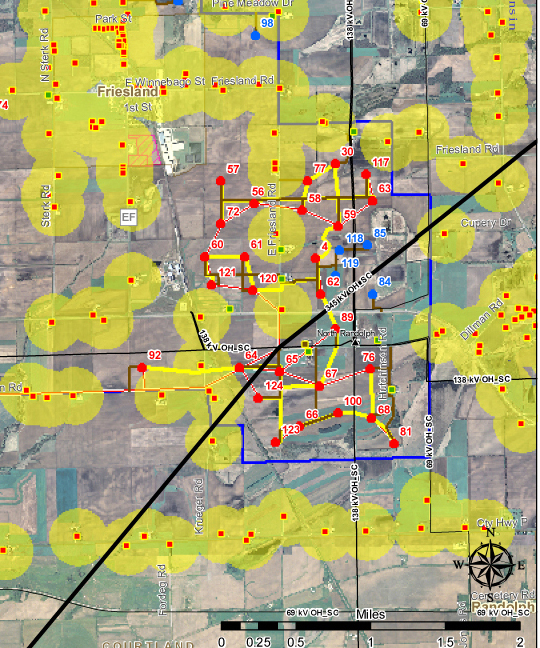
The image above is a detail map of We Energies Glacier Hills project currently under construction in Columbia county. The red squares in yellow circles are the non participating homes in the project. The red dots represent the wind turbines. Below is a small map of the entire project.
The PSC approved the project with setbacks of 1250 feet. The yellow circles below indicate a 1000 foot setback from non-participating homes in the project.
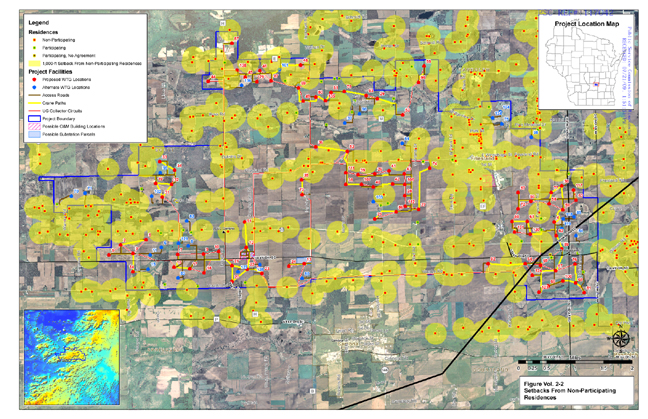
FEATURE OF THE DAY:
NEW STUDY SAYS:
BIG NEW WIND TURBINES TOO CLOSE TOGETHER
January 21, 2010
By Lewis Page
“I believe our results are quite robust,” says Meneveau. “They indicate that large wind farm operators are going to have to space their turbines farther apart.”
Big turbines are at the moment generally installed about seven rotor diameters apart, but Meneveau and Meyers say that the optimum spacing is actually 15 diameters, slightly more than twice as far apart.
If this plan were followed, a wind farm covering a given area would only be able to install a quarter of the number of turbines it could have under today's planning assumptions."
A top American fluid-dynamics boffin says that new, larger wind turbines now going into service are going to have to be placed much further apart - which will have serious implications for the amount of energy produced by wind farms of the future.
The latest wind farms now going into service use huge turbines with rotor diameters in the 100m range, expected to offer large outputs. But according to engineering professor and fluid dynamics expert Charles Meneveau of Johns Hopkins University, there's a problem.
“The early experience is that they are producing less power than expected,” says Meneveau. “Some of these projects are underperforming.”
The prof, who has investigated air flow in wind farms for years, looked into the matter of the underperforming monster turbines along with Johan Meyers of the Katholieke Universiteit Leuven in Belgium.
“I believe our results are quite robust,” says Meneveau. “They indicate that large wind farm operators are going to have to space their turbines farther apart.”
Big turbines are at the moment generally installed about seven rotor diameters apart, but Meneveau and Meyers say that the optimum spacing is actually 15 diameters, slightly more than twice as far apart.
If this plan were followed, a wind farm covering a given area would only be able to install a quarter of the number of turbines it could have under today's planning assumptions. Though the amount of energy generated per turbine would be the best possible, it seems unlikely that such efficiency gains could possibly compensate for the cut in numbers.
On the other hand, if windfarms continue to be constructed with turbines crowded more closely together, they will continue to produce less electricity than their builders had expected.
Overall the professor's research would appear to mean that projected output figures for large new windfarms - for instance the UK's planned, enormous offshore Round 3 facilities, expected to be built in the North Sea from 2015 - will have to be revised downwards one way or another.
Professor Meneveau presented the research, based on wind tunnel studies carried out at Johns Hopkins, at a physics conference recently. The outlines of it are reported in The John Hopkins University Gazette. ®
 EXTRA CREDIT READING:
EXTRA CREDIT READING:
TELL THEM NO:
WHAT DID THE JUDGE SAY TO THE CALIFORNIA PUBLIC UTILITIES COMMISSIONERS ABOUT PACIFIC GAS AND ELECTRIC COMPANY APPLYING TO BUYING A HUGE WIND FARM FROM IBERDROLA?
THE JUDGE DIDN'T THINK IT WAS A GOOD IDEA. HERE IS WHY:
“We reject the application because we find that the Manzana Wind Project is not cost-competitive and poses unacceptable risks to ratepayers.
We find that the proposed cost of the Manzana Wind Project is significantly higher than other resources PG&E can procure to meet its RPS program goal.
Moreover, it will subject the ratepayers to unacceptable risks due to potential cost increases resulting from project under-performance, less than forecasted project life, and any delays which might occur concerning transmission upgrades and commercial online date.
As a proposed utility-owned generation project, ratepayers would pay a lump sum cost rather than a performance based cost for the Manzana Wind Project.
Therefore, ratepayers would be at risk if the project underperforms.
In particular, if the Manzana Wind Project fails to achieve production as expected for any reason such as construction delays or curtailments as a result of a collision with a California condor, shareholders face no risks while customers could incur increased costs"
READ THE ENTIRE STORY BY CLICKING HERE
Visit PG&E's website by clicking here
Visit Iberdrola's website by clicking here
12/20/10 Radio Radio: Listen to wind rules discussed on WORT'S 'A Public Affair' AND! This Just In: Yet another letter from legislators to Senator Plale asking him to object to the wind rules BUT Is there a mailbox in his spider hole?
EXTRA CREDIT READING:
CLICK HERE for Clean Wisconsin's 2009 testimony to the Public Service Commission during the Glacier Hills Wind Project hearings--Clean Wisconsin tells the PSC there will no CO2 reduction because of the implementation of the Glacier Hills project unless the PSC also requires a coal fired plant to be shut down.
Result: The PSC approves the project with no requirement that a coal-fired plant to be shut down.
12/7/09 Clean Wisconsin lives up to its name by taking on the dirty elephant in the room.
December 16, 2010
Dear Senator Plale and Representative Soletski,
We are writing to express our concerns regarding Clearinghouse Rule 10-057 which sets state-wide standards for the siting of wind towers.
The Rule pending before your committee should be sent back to the Public Service Commission for modifications.
We appreciate the work of both committees on this proposed rule. Much of the citizen reaction, including that of your constituents raised serious concerns about the effects of the rule. We are grateful for the committee action in October to return the rule to the PSC for modifications.
Unfortunately, the PSC modified Rule sent back to your committee this month does not address the concerns expressed by citizens of members of your committee.
Specifically, we are deeply concerned about the setback provisions and its effect on neighbors to properties containing wind towers. Substantial testimony was provided by citizens describing this setback as completely unacceptable.
It seems the PSC has entirely disregarded the will of Wisconsin's citizens and elected officials.
We respectfully urge you to consider the will of the people and those whom they have elected. We ask the committee to either return the rule to the PSC for further modifications or act quickly to object to the proposed rule so it can be taken up the Joint Committee on Review of Administrative Rules.
Thank you for your attention to this matter,
Sincerely,
Kathleen Vinehout
State Senator
31st Senate District
Chris Danou
State Representative
91st Assembly District
